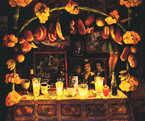Elena Climent
In Search of the Present
|
 |
|
Interview with Elena Climent
Edward J. Sullivan
|
|
| | page 1 | page 2 |
page 3 | page 4 | |

Yellow Wall with Birdcage, 1990
|
|
|
|
| EJS
|
Since when have you been concentrating in your art on scenes of
domestic middle class reality in Mexico?
|
| EC
|
I must have begun to paint in this way in about 1986. Before that I had
painted things that had to do in a certain sense with what I paint now. I've
always done interior views but the earlier ones were more imaginary. They
were loaded with nostalgia. When I was growing up, nostalgia was a very
strong force in our lives. Anyway, I began to realize that my "imaginary"
paintings were becoming too repetitious and so I began to look outside my
own reality.
|
| EJS
|
I know that much of your earlier work was in a somewhat surrealist
vein.
|
| EC
|
Well, in a way I'd always been involved in both the real and what you
might call the surreal. It's like an artistic schizophrenia. The world in which
I was raised was very divorced from real life. Our father, an exile from the
Spanish Civil War had created a scale of aesthetic values for us that was
really ferocious. The separation of our lives inside the family circle from
the outside was really dramatic. The aesthetic ideas with which I grew up
were more European, more classical. Symmetry and harmony were important.
But the rules we followed weren't those that existed in Mexico. For example,
as children we always had to dress within a certain range of colors. We
couldn't wear anything too bright because that would be considered vulgar.
Lack of order was also something not to be tolerated. Good taste was
everything for my family. Everything had to be exquisite and refined.
|
| EJS
|
Would you say that this type of attitude toward life was "anti-Mexican"
in a sense?
|
| EC
|
No, not anti-Mexican but just unrealistic. In fact, there were many
people in my father's circle who were very concerned about traditional
Mexican things-objects, old woods, natural fibers and so on-plastic was
considered horrible. They were concerned about so many things that were
part of a Mexican reality that no longer existed. They tried to reject the
banal things of life. And those everyday things were the ones I ultimately
realized I had to depict in my work.
However, I think it's important to explain that this aesthetically rigid
upbringing was actually a very positive aspect of my development. It was so
overwhelming and people were so secure in their ideas about how things
should be that it made it all the more important for me to fight it and rebel
against it. It actually gave me the strength to generate my own vision, my
own path for my art. I also have to recognize that the influence of my father
on my art was in so many ways of enormous importance for me. He taught me
a great deal and I am very grateful for his influence.
|
|
| continued |
|






|











